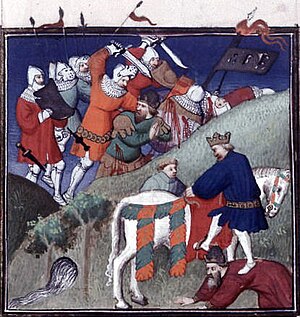Battle of Manzikert
| Battle of Manzikert نبرد ملازگرد |
|||||||
|---|---|---|---|---|---|---|---|
| Part of the Byzantine–Seljuq wars | |||||||
 In this 15th-century French miniature depicting the Battle of Manzikert, the combatants are clad in contemporary Western European armour. |
|||||||
|
|||||||
| Belligerents | |||||||
| Byzantine Empire | Seljuk Empire | ||||||
| Commanders and leaders | |||||||
| Romanos IV (POW) Nikephoros Bryennios Theodore Alyates Andronikos Doukas |
Alp Arslan Afshin Bey Artuk Bey Kutalmışoğlu Suleyman |
||||||
| Strength | |||||||
| 40,000 to 70,000 | 20,000 to 30,000 | ||||||
| Casualties and losses | |||||||
|
Killed: 2,000 to 8,000
Captured: 4,000Deserted: 20,000 to 35,000
|
unknown | ||||||
Killed: 2,000 to 8,000
Captured: 4,000Deserted: 20,000 to 35,000
The Battle of Manzikert (Turkish: Malazgirt Meydan Muharebesi; Arabic: معركة ملاذكرد) was fought between the Byzantine Empire and the Seljuq Turks on August 26, 1071 near Manzikert (modern Malazgirt in Muş Province, Turkey). The decisive defeat of the Byzantine army and the capture of the Emperor Romanos IV Diogenes played an important role in undermining Byzantine authority in Anatolia and Armenia, and allowed for the gradual Turkification of Anatolia. Many of the Turks, who had been, during the 11th century, travelling westward, saw the victory at Manzikert as an entrance to Asia Minor.
The brunt of the battle was borne by the professional soldiers from the eastern and western tagmata, as large numbers of mercenaries and Anatolian levies fled early and survived the battle. The fallout from Manzikert was disastrous for the Byzantines, resulting in civil conflicts and an economic crisis that severely weakened the Byzantine Empire's ability to adequately defend its borders. This led to the mass movement of Turks into central Anatolia—by 1080, an area of 78,000 square kilometres (30,000 sq mi) had been gained by the Seljuk Turks. It took three decades of internal strife before Alexius I (1081 to 1118) restored stability to Byzantium. Historian Thomas Asbridge says: "In 1071, the Seljuqs crushed an imperial army at the Battle of Manzikert (in eastern Asia Minor), and though historians no longer consider this to have been an utterly cataclysmic reversal for the Greeks, it still was a stinging setback." It was the first time in history a Byzantine Emperor had become the prisoner of a Muslim commander.
...
Wikipedia
